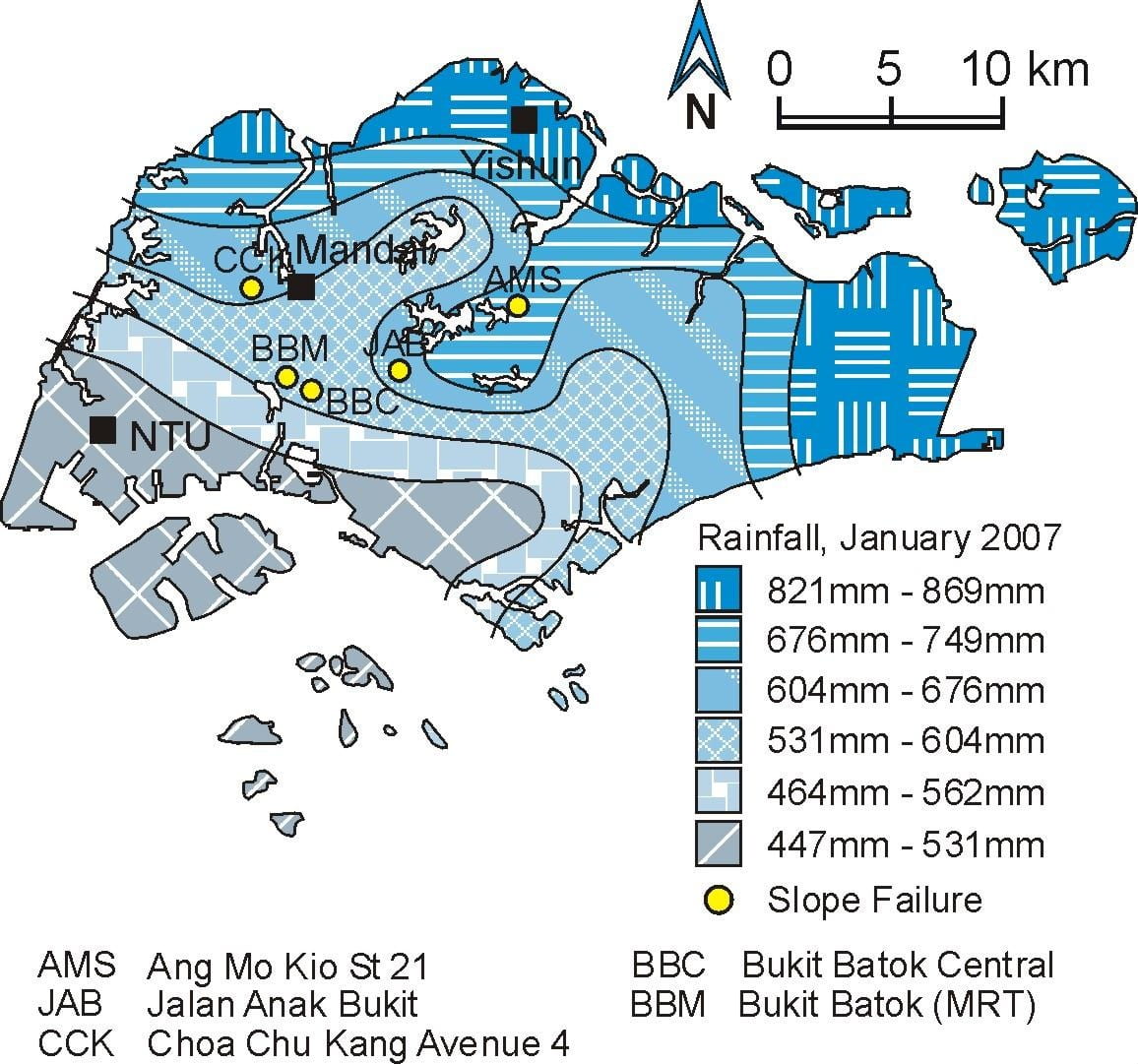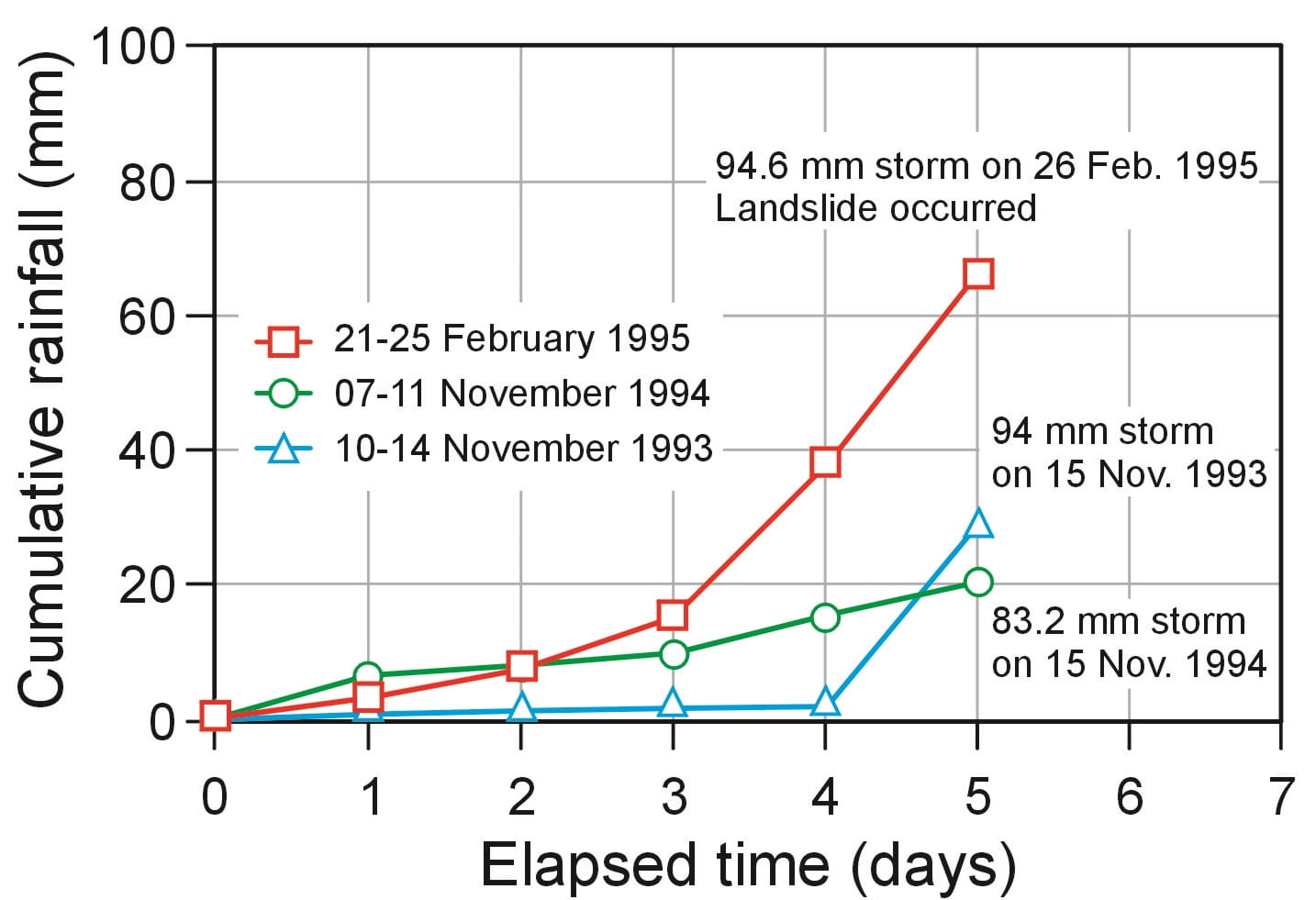Unsaturated Soil Mechanics for Slope Stability Analyses

Mechanisms of rainfall-induced slope failure, Rahardjo et al 2012
Numerous slope failures occur in steep residual soil slopes with a deep groundwater table during rainfalls. A significant thickness of unsaturated soil zone above the groundwater table is a general characteristic of steep residual soil slopes. The negative pore-water pressure in unsaturated soil is highly influenced by the flux boundary condition changes (i.e., infiltration, evaporation and transpiration) resulting from the variation in climatic conditions. On the other hand, the negative pore-water pressure contributes additional shear strength to the unsaturated soil. As water infiltrates into the slope, pore-water pressure in the slope increases (matric suction decreases), and the additional shear strength due to matric suction will decrease or even disappear, causing the slope to be more susceptible to failure. Evaporation and transpiration will restore the loss of matric suction in the slope and this climatic variation occurs at all times. In other words, the unsaturated zone is a dynamic interface of the slope with the environment and as a result, factor of safety of slope is affected dynamically by climatic changes.

Rainfall-induced slope failure within residual soil, Rahardjo et al 2005
References
- Kassim, A., Lee, M. L., Gofar, N. and Rahardjo, H. (2012). “Modelling of suction distributions in an unsaturated heterogeneous residual soil slope”.Engineering Geology, 131-132, 70-82. doi | handle
- Rahardjo, H., Satyanaga, A. and Leong, E. C. (2012). “Unsaturated soil mechanics for slope stabilization.” Geotechnical Engineering Journal of the SEAGS & AGSSEA, March, 43(1), 48-58.
- Rahardjo, H., Santoso, V. A., Leong, E. C., Ng, Y. S. and Hua, C. J. (2011). “Performance of horizontal drains in residual soil slope.” Soils and Foundations, Japanese Geotechnical Society, June, 51(3), 437-447. doi | handle
- Rahimi, A., Rahardjo, H. and Leong, E. C. (2011). “Effect of antecedent rainfall patterns on rainfall induced slope failure.” ASCE Journal of Geotechnical and Geoenvironmental Engineering, May, 137(5), 483-491. doi | handle
- Rahardjo, H., Satyanaga, A., Leong, E. C. and Ng, Y. S. (2010). “Effects of groundwater table position and soil properties on stability of slope during rainfall.” ASCE Journal of Geotechnical and Geoenvironmental Engineering. November, 136(11), 1555–1564. doi | handle
- Rahimi, A., Rahardjo, H. and Leong, E. C. (2010). “Effect of hydraulic properties of soil on rainfall-induced slope failure.” Journal of Engineering Geology, 114, 135-143. doi | handle
- Schnellmann, R., Busslinger, M., Schneider, H. and Rahardjo, H. (2010). “Effect of rising water table in an unsaturated slope.” Journal of Engineering Geology, 114, 71-83. doi | handle
- Lee, M. L., Gofar, N. and Rahardjo, H. (2009). “A simple model for preliminary evaluation of rainfall-induced slope instability.” Journal of Engineering Geology, 108, 272-285. doi| handle
- Rahardjo, H., Ong, T. H., Rezaur, R. B. and Leong, E. C. (2007). “Factors controlling instability of homogeneous soil slopes under rainfall loading.” ASCE Journal of Geotechnical and Geoenvironmental Engineering. December, 133(12), 1532-1543. doi| handle
- Rahardjo, H., Lee, T. T., Leong, E. C. and Rezaur, R. B. (2006). Reply to Discussion by Londono A.C. on “Response of a residual soil slope to rainfall.” by Rahardjo, H., Lee, T. T., Leong, E. C. and Rezaur, R. B. [Canadian Geotechnical Journal, 42: 340 – 351 (2005)]. Canadian Geotechnical Journal, September, 43, 979-984. doi | handle
- Rahardjo, H., Lee, T. T., Leong, E. C. and Rezaur, R. B. (2005). “Response of a residual soil slope to rainfall.” Canadian Geotechnical Journal, April, 42(2), 340-351. doi | handle
- Rahardjo, H., Rezaur, R. B., Hritzuk, K. J., Leong, E. C. (2005). “Slope failures in Singapore : case study of two landslides.” KEYNOTE LECTURE. Proceedings of International Seminar on Slope Disasters in Geomorphological / Geotechnical Engineering, Kobe, Japan, 9-10 September, 59–70.
- Tsaparas, I., Rahardjo, H., Toll, D. G. and Leong, E. C. (2003). “Infiltration characteristics of two instrumented residual soil slopes.” Canadian Geotechnical Journal, October, 40(5), 1012 – 1032. doi | handle
- Rezaur, R. B., Rahardjo, H., Leong, E. C. and Lee, T. T. (2003). “Hydrologic behaviour of residual soil slopes in Singapore.” ASCE Journal of Hydrologic Engineering. May/June, 8(3), 133-144. doi | handle
- Rezaur, R. B., Rahardjo, H. and Leong, E. C. (2002). “Spatial and temporal variability of pore-water pressures in residual soil slopes in a tropical climate.” Earth Surface Processes and Landforms, March, 27, 317-338. doi| handle
- Tsaparas, I., Rahardjo, H., Toll, D. G. and Leong, E. C. (2002). “Controlling parameters for rainfall-induced landslides.” Computer and Geotechnics, January, 29(1), 1-27. doi | handle
- Rahardjo, H., Li, X. W., Toll, D. G. and Leong, E. C. (2001). “The effect of antecedent rainfall on slope stability.” Journal of Geotechnical and Geological Engineering, Special Issue on “Unsaturated and Collapsible Soils,” September, 19(3-4), 371-399. doi | handle
- Gasmo, J. M., Rahardjo, H. and Leong, E. C. (2000). “Infiltration effects on stability of a residual soil slope.” Computer and Geotechnics, 26, April, 145 – 165. doi | handle
Rainfall and slope failure data
Distribution of rainfall and slope failures during the month of December 2006 (after NEA, 2006), Rahardjo et al 2007
Distribution of rainfall and slope failures during the month of January 2007 (after NEA, 2007), Rahardjo et al 2007
Antecedent rainfall and slope failure in Singapore, Rahardjo et al 2001



